Case Study: Exercise Prescription and Physiology for Mrs. Door
VerifiedAdded on 2022/11/30
|9
|2426
|343
Report
AI Summary
This report presents a detailed analysis of a case study involving Mrs. Door, a 67-year-old female with a history of diabetes scheduled for pancreatic surgery to remove a benign tumor. The report begins with an introduction to the case, outlining Mrs. Door's medical history, current physical condition, and lifestyle. It then identifies specific problems and goals, including her inability to perform certain movements and her desire to improve fitness for surgery. The report also presents a series of testing procedures and outcome measures, such as the Single Stage Treadmill Walking Test, Up and Go Timed Test, Sit and Stand Test, and Back Scratch Test, to assess and monitor her progress. The report concludes with a summary of the findings and recommendations for safe, inexpensive, and physiology-appropriate exercises to improve Mrs. Door's mobility, fitness, and overall well-being, considering her age, health conditions, and past experiences with exercise programs. The report emphasizes the importance of addressing both her physical and psychological needs to ensure a successful outcome.
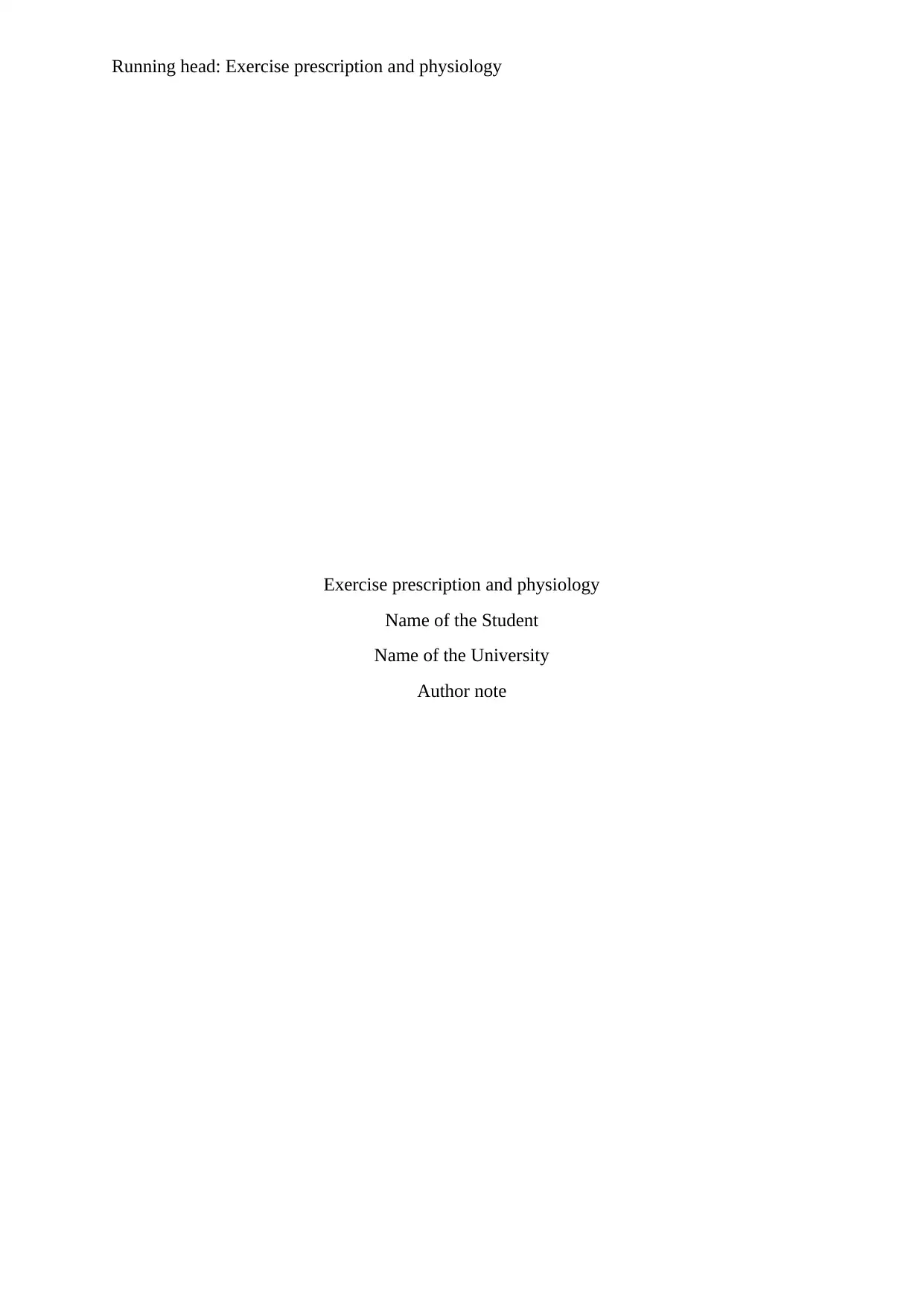
Running head: Exercise prescription and physiology
Exercise prescription and physiology
Name of the Student
Name of the University
Author note
Exercise prescription and physiology
Name of the Student
Name of the University
Author note
Paraphrase This Document
Need a fresh take? Get an instant paraphrase of this document with our AI Paraphraser
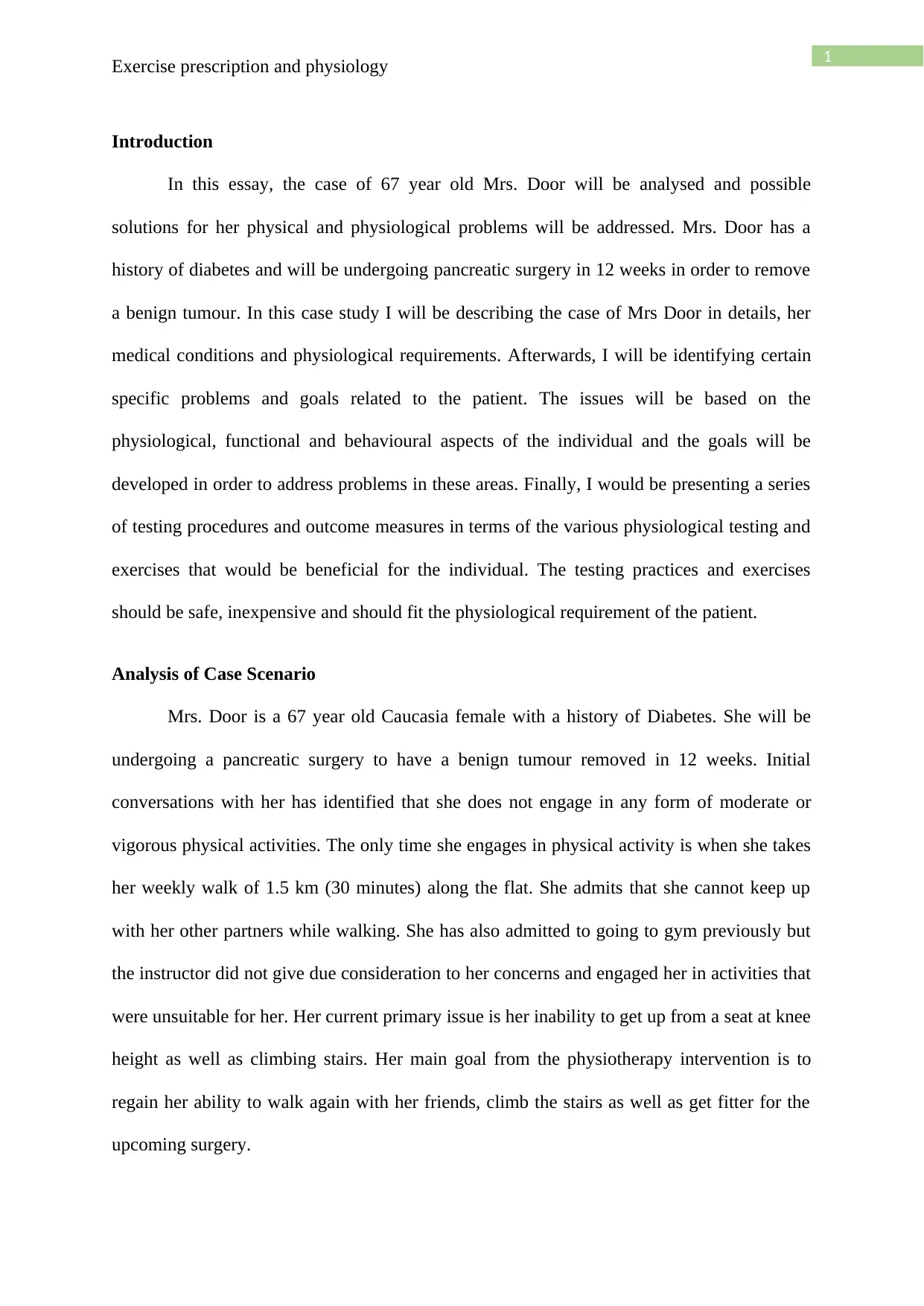
1
Exercise prescription and physiology
Introduction
In this essay, the case of 67 year old Mrs. Door will be analysed and possible
solutions for her physical and physiological problems will be addressed. Mrs. Door has a
history of diabetes and will be undergoing pancreatic surgery in 12 weeks in order to remove
a benign tumour. In this case study I will be describing the case of Mrs Door in details, her
medical conditions and physiological requirements. Afterwards, I will be identifying certain
specific problems and goals related to the patient. The issues will be based on the
physiological, functional and behavioural aspects of the individual and the goals will be
developed in order to address problems in these areas. Finally, I would be presenting a series
of testing procedures and outcome measures in terms of the various physiological testing and
exercises that would be beneficial for the individual. The testing practices and exercises
should be safe, inexpensive and should fit the physiological requirement of the patient.
Analysis of Case Scenario
Mrs. Door is a 67 year old Caucasia female with a history of Diabetes. She will be
undergoing a pancreatic surgery to have a benign tumour removed in 12 weeks. Initial
conversations with her has identified that she does not engage in any form of moderate or
vigorous physical activities. The only time she engages in physical activity is when she takes
her weekly walk of 1.5 km (30 minutes) along the flat. She admits that she cannot keep up
with her other partners while walking. She has also admitted to going to gym previously but
the instructor did not give due consideration to her concerns and engaged her in activities that
were unsuitable for her. Her current primary issue is her inability to get up from a seat at knee
height as well as climbing stairs. Her main goal from the physiotherapy intervention is to
regain her ability to walk again with her friends, climb the stairs as well as get fitter for the
upcoming surgery.
Exercise prescription and physiology
Introduction
In this essay, the case of 67 year old Mrs. Door will be analysed and possible
solutions for her physical and physiological problems will be addressed. Mrs. Door has a
history of diabetes and will be undergoing pancreatic surgery in 12 weeks in order to remove
a benign tumour. In this case study I will be describing the case of Mrs Door in details, her
medical conditions and physiological requirements. Afterwards, I will be identifying certain
specific problems and goals related to the patient. The issues will be based on the
physiological, functional and behavioural aspects of the individual and the goals will be
developed in order to address problems in these areas. Finally, I would be presenting a series
of testing procedures and outcome measures in terms of the various physiological testing and
exercises that would be beneficial for the individual. The testing practices and exercises
should be safe, inexpensive and should fit the physiological requirement of the patient.
Analysis of Case Scenario
Mrs. Door is a 67 year old Caucasia female with a history of Diabetes. She will be
undergoing a pancreatic surgery to have a benign tumour removed in 12 weeks. Initial
conversations with her has identified that she does not engage in any form of moderate or
vigorous physical activities. The only time she engages in physical activity is when she takes
her weekly walk of 1.5 km (30 minutes) along the flat. She admits that she cannot keep up
with her other partners while walking. She has also admitted to going to gym previously but
the instructor did not give due consideration to her concerns and engaged her in activities that
were unsuitable for her. Her current primary issue is her inability to get up from a seat at knee
height as well as climbing stairs. Her main goal from the physiotherapy intervention is to
regain her ability to walk again with her friends, climb the stairs as well as get fitter for the
upcoming surgery.
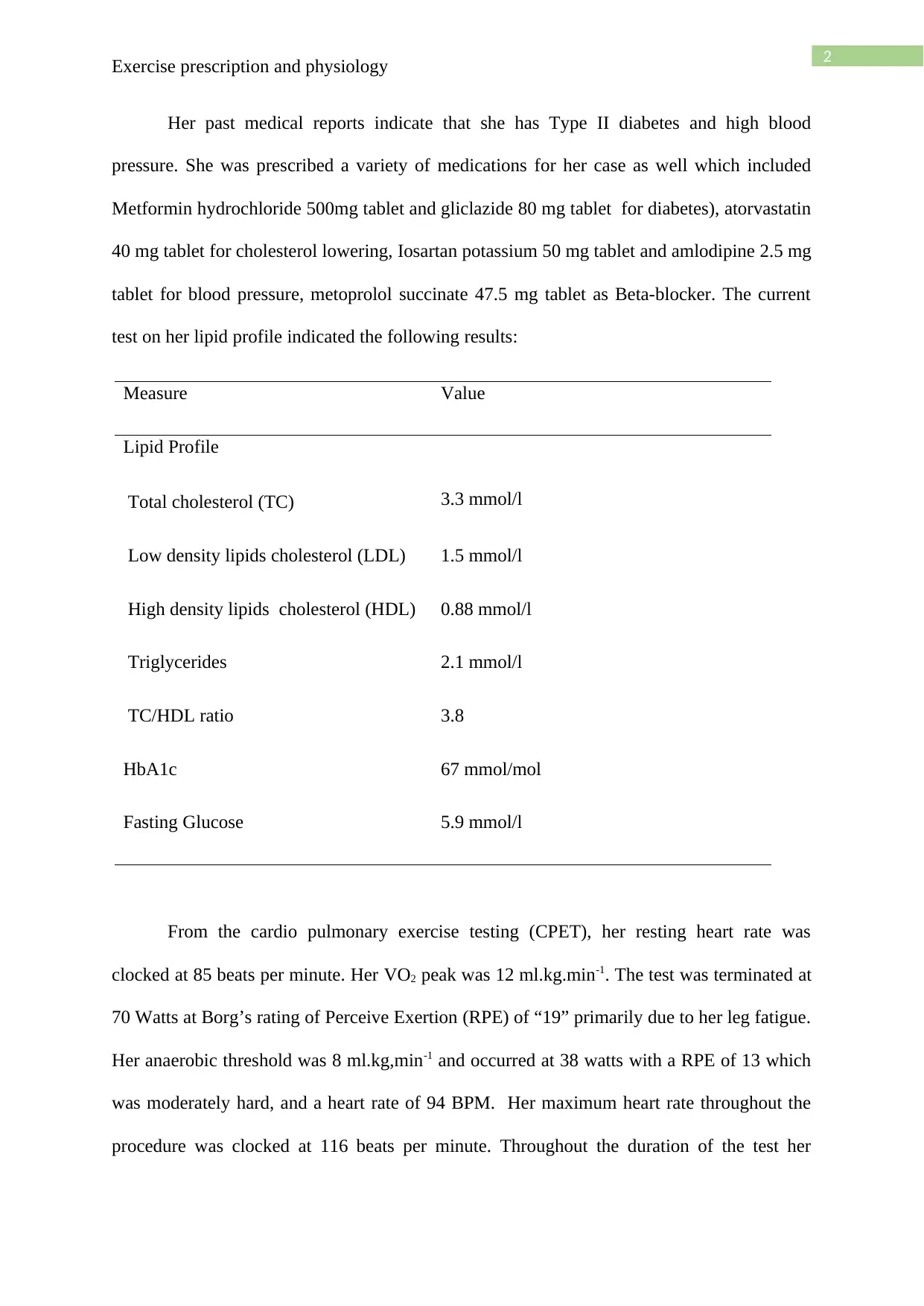
2
Exercise prescription and physiology
Her past medical reports indicate that she has Type II diabetes and high blood
pressure. She was prescribed a variety of medications for her case as well which included
Metformin hydrochloride 500mg tablet and gliclazide 80 mg tablet for diabetes), atorvastatin
40 mg tablet for cholesterol lowering, Iosartan potassium 50 mg tablet and amlodipine 2.5 mg
tablet for blood pressure, metoprolol succinate 47.5 mg tablet as Beta-blocker. The current
test on her lipid profile indicated the following results:
Measure Value
Lipid Profile
Total cholesterol (TC) 3.3 mmol/l
Low density lipids cholesterol (LDL) 1.5 mmol/l
High density lipids cholesterol (HDL) 0.88 mmol/l
Triglycerides 2.1 mmol/l
TC/HDL ratio 3.8
HbA1c 67 mmol/mol
Fasting Glucose 5.9 mmol/l
From the cardio pulmonary exercise testing (CPET), her resting heart rate was
clocked at 85 beats per minute. Her VO2 peak was 12 ml.kg.min-1. The test was terminated at
70 Watts at Borg’s rating of Perceive Exertion (RPE) of “19” primarily due to her leg fatigue.
Her anaerobic threshold was 8 ml.kg,min-1 and occurred at 38 watts with a RPE of 13 which
was moderately hard, and a heart rate of 94 BPM. Her maximum heart rate throughout the
procedure was clocked at 116 beats per minute. Throughout the duration of the test her
Exercise prescription and physiology
Her past medical reports indicate that she has Type II diabetes and high blood
pressure. She was prescribed a variety of medications for her case as well which included
Metformin hydrochloride 500mg tablet and gliclazide 80 mg tablet for diabetes), atorvastatin
40 mg tablet for cholesterol lowering, Iosartan potassium 50 mg tablet and amlodipine 2.5 mg
tablet for blood pressure, metoprolol succinate 47.5 mg tablet as Beta-blocker. The current
test on her lipid profile indicated the following results:
Measure Value
Lipid Profile
Total cholesterol (TC) 3.3 mmol/l
Low density lipids cholesterol (LDL) 1.5 mmol/l
High density lipids cholesterol (HDL) 0.88 mmol/l
Triglycerides 2.1 mmol/l
TC/HDL ratio 3.8
HbA1c 67 mmol/mol
Fasting Glucose 5.9 mmol/l
From the cardio pulmonary exercise testing (CPET), her resting heart rate was
clocked at 85 beats per minute. Her VO2 peak was 12 ml.kg.min-1. The test was terminated at
70 Watts at Borg’s rating of Perceive Exertion (RPE) of “19” primarily due to her leg fatigue.
Her anaerobic threshold was 8 ml.kg,min-1 and occurred at 38 watts with a RPE of 13 which
was moderately hard, and a heart rate of 94 BPM. Her maximum heart rate throughout the
procedure was clocked at 116 beats per minute. Throughout the duration of the test her
⊘ This is a preview!⊘
Do you want full access?
Subscribe today to unlock all pages.

Trusted by 1+ million students worldwide
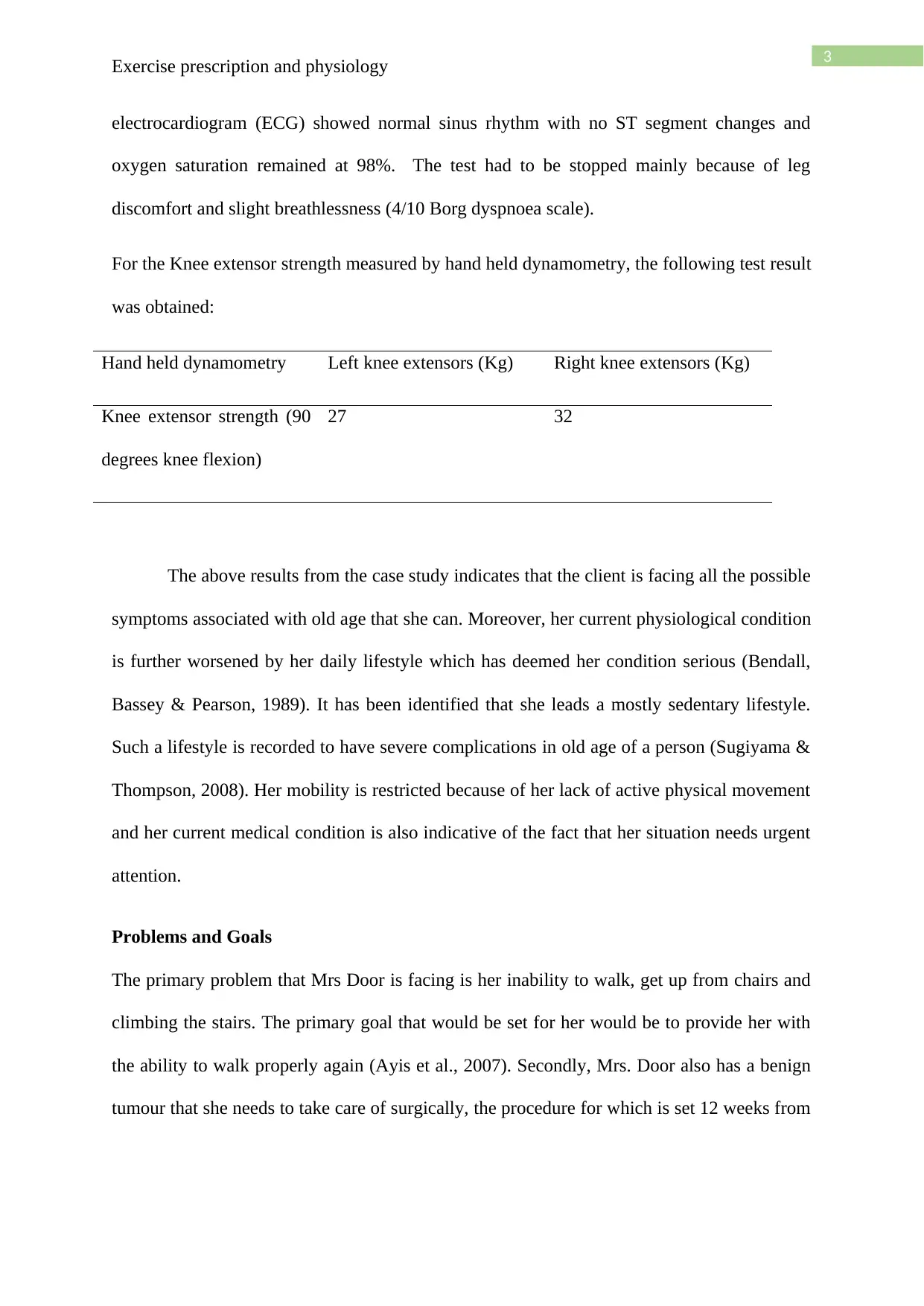
3
Exercise prescription and physiology
electrocardiogram (ECG) showed normal sinus rhythm with no ST segment changes and
oxygen saturation remained at 98%. The test had to be stopped mainly because of leg
discomfort and slight breathlessness (4/10 Borg dyspnoea scale).
For the Knee extensor strength measured by hand held dynamometry, the following test result
was obtained:
Hand held dynamometry Left knee extensors (Kg) Right knee extensors (Kg)
Knee extensor strength (90
degrees knee flexion)
27 32
The above results from the case study indicates that the client is facing all the possible
symptoms associated with old age that she can. Moreover, her current physiological condition
is further worsened by her daily lifestyle which has deemed her condition serious (Bendall,
Bassey & Pearson, 1989). It has been identified that she leads a mostly sedentary lifestyle.
Such a lifestyle is recorded to have severe complications in old age of a person (Sugiyama &
Thompson, 2008). Her mobility is restricted because of her lack of active physical movement
and her current medical condition is also indicative of the fact that her situation needs urgent
attention.
Problems and Goals
The primary problem that Mrs Door is facing is her inability to walk, get up from chairs and
climbing the stairs. The primary goal that would be set for her would be to provide her with
the ability to walk properly again (Ayis et al., 2007). Secondly, Mrs. Door also has a benign
tumour that she needs to take care of surgically, the procedure for which is set 12 weeks from
Exercise prescription and physiology
electrocardiogram (ECG) showed normal sinus rhythm with no ST segment changes and
oxygen saturation remained at 98%. The test had to be stopped mainly because of leg
discomfort and slight breathlessness (4/10 Borg dyspnoea scale).
For the Knee extensor strength measured by hand held dynamometry, the following test result
was obtained:
Hand held dynamometry Left knee extensors (Kg) Right knee extensors (Kg)
Knee extensor strength (90
degrees knee flexion)
27 32
The above results from the case study indicates that the client is facing all the possible
symptoms associated with old age that she can. Moreover, her current physiological condition
is further worsened by her daily lifestyle which has deemed her condition serious (Bendall,
Bassey & Pearson, 1989). It has been identified that she leads a mostly sedentary lifestyle.
Such a lifestyle is recorded to have severe complications in old age of a person (Sugiyama &
Thompson, 2008). Her mobility is restricted because of her lack of active physical movement
and her current medical condition is also indicative of the fact that her situation needs urgent
attention.
Problems and Goals
The primary problem that Mrs Door is facing is her inability to walk, get up from chairs and
climbing the stairs. The primary goal that would be set for her would be to provide her with
the ability to walk properly again (Ayis et al., 2007). Secondly, Mrs. Door also has a benign
tumour that she needs to take care of surgically, the procedure for which is set 12 weeks from
Paraphrase This Document
Need a fresh take? Get an instant paraphrase of this document with our AI Paraphraser
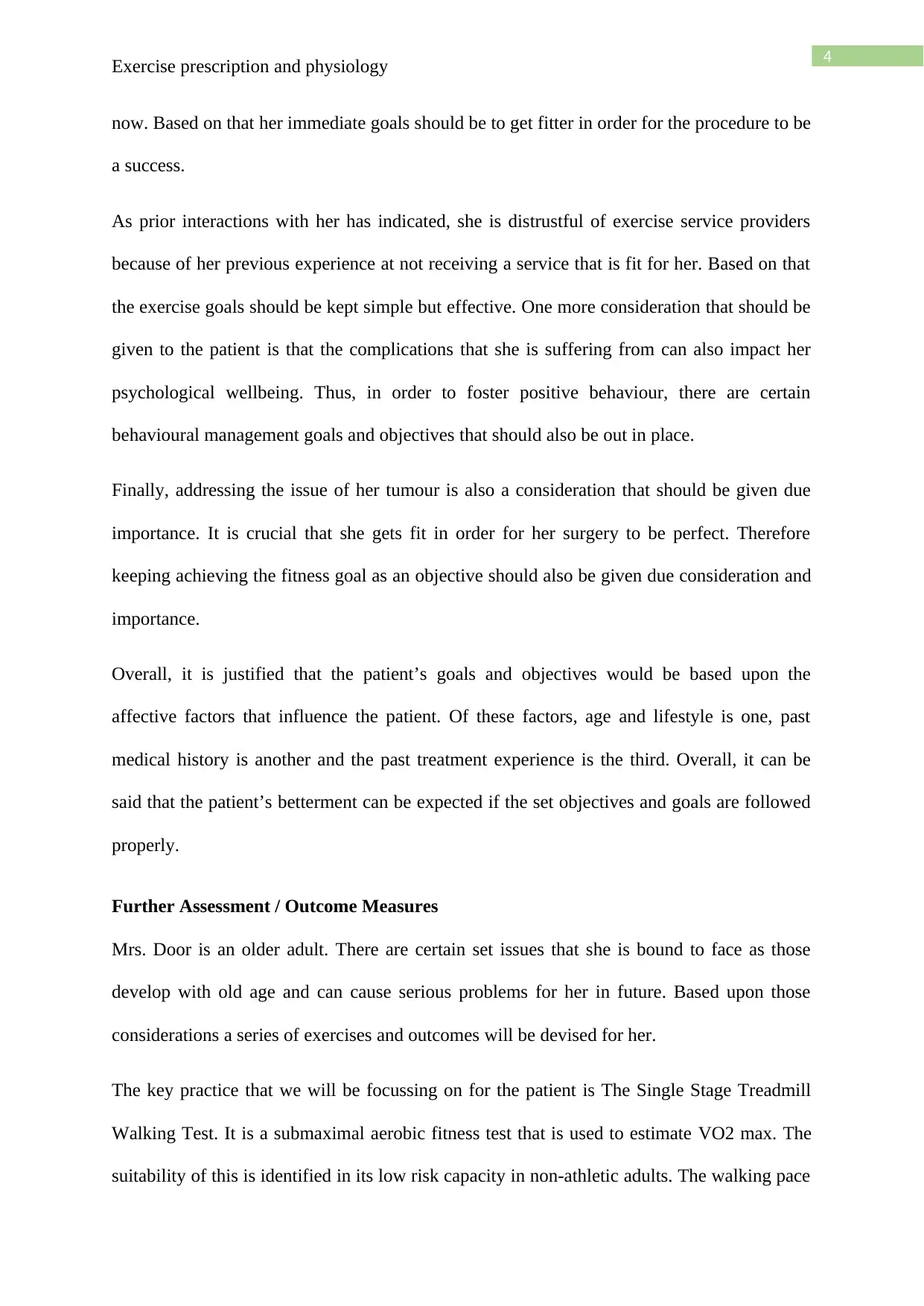
4
Exercise prescription and physiology
now. Based on that her immediate goals should be to get fitter in order for the procedure to be
a success.
As prior interactions with her has indicated, she is distrustful of exercise service providers
because of her previous experience at not receiving a service that is fit for her. Based on that
the exercise goals should be kept simple but effective. One more consideration that should be
given to the patient is that the complications that she is suffering from can also impact her
psychological wellbeing. Thus, in order to foster positive behaviour, there are certain
behavioural management goals and objectives that should also be out in place.
Finally, addressing the issue of her tumour is also a consideration that should be given due
importance. It is crucial that she gets fit in order for her surgery to be perfect. Therefore
keeping achieving the fitness goal as an objective should also be given due consideration and
importance.
Overall, it is justified that the patient’s goals and objectives would be based upon the
affective factors that influence the patient. Of these factors, age and lifestyle is one, past
medical history is another and the past treatment experience is the third. Overall, it can be
said that the patient’s betterment can be expected if the set objectives and goals are followed
properly.
Further Assessment / Outcome Measures
Mrs. Door is an older adult. There are certain set issues that she is bound to face as those
develop with old age and can cause serious problems for her in future. Based upon those
considerations a series of exercises and outcomes will be devised for her.
The key practice that we will be focussing on for the patient is The Single Stage Treadmill
Walking Test. It is a submaximal aerobic fitness test that is used to estimate VO2 max. The
suitability of this is identified in its low risk capacity in non-athletic adults. The walking pace
Exercise prescription and physiology
now. Based on that her immediate goals should be to get fitter in order for the procedure to be
a success.
As prior interactions with her has indicated, she is distrustful of exercise service providers
because of her previous experience at not receiving a service that is fit for her. Based on that
the exercise goals should be kept simple but effective. One more consideration that should be
given to the patient is that the complications that she is suffering from can also impact her
psychological wellbeing. Thus, in order to foster positive behaviour, there are certain
behavioural management goals and objectives that should also be out in place.
Finally, addressing the issue of her tumour is also a consideration that should be given due
importance. It is crucial that she gets fit in order for her surgery to be perfect. Therefore
keeping achieving the fitness goal as an objective should also be given due consideration and
importance.
Overall, it is justified that the patient’s goals and objectives would be based upon the
affective factors that influence the patient. Of these factors, age and lifestyle is one, past
medical history is another and the past treatment experience is the third. Overall, it can be
said that the patient’s betterment can be expected if the set objectives and goals are followed
properly.
Further Assessment / Outcome Measures
Mrs. Door is an older adult. There are certain set issues that she is bound to face as those
develop with old age and can cause serious problems for her in future. Based upon those
considerations a series of exercises and outcomes will be devised for her.
The key practice that we will be focussing on for the patient is The Single Stage Treadmill
Walking Test. It is a submaximal aerobic fitness test that is used to estimate VO2 max. The
suitability of this is identified in its low risk capacity in non-athletic adults. The walking pace
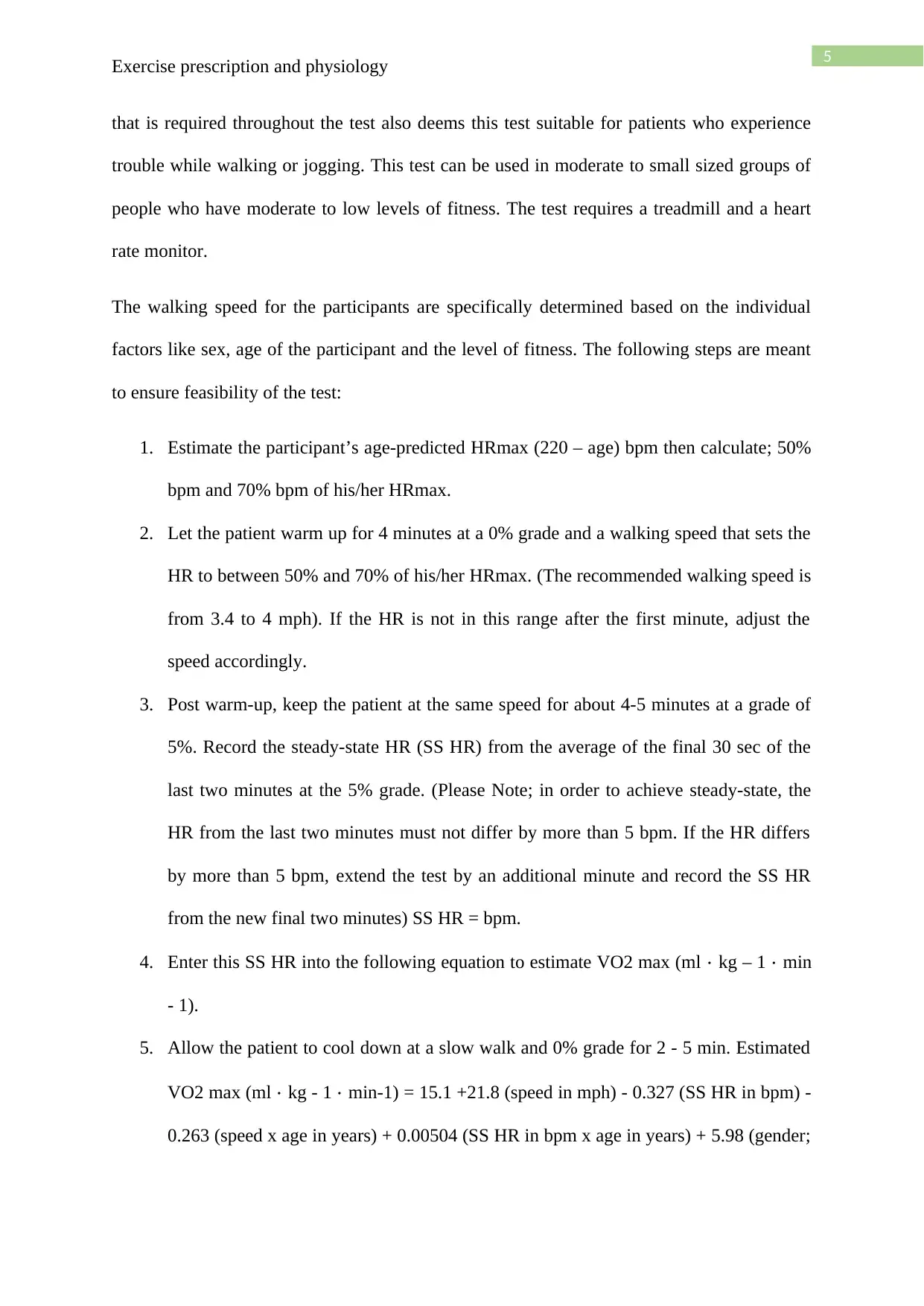
5
Exercise prescription and physiology
that is required throughout the test also deems this test suitable for patients who experience
trouble while walking or jogging. This test can be used in moderate to small sized groups of
people who have moderate to low levels of fitness. The test requires a treadmill and a heart
rate monitor.
The walking speed for the participants are specifically determined based on the individual
factors like sex, age of the participant and the level of fitness. The following steps are meant
to ensure feasibility of the test:
1. Estimate the participant’s age-predicted HRmax (220 – age) bpm then calculate; 50%
bpm and 70% bpm of his/her HRmax.
2. Let the patient warm up for 4 minutes at a 0% grade and a walking speed that sets the
HR to between 50% and 70% of his/her HRmax. (The recommended walking speed is
from 3.4 to 4 mph). If the HR is not in this range after the first minute, adjust the
speed accordingly.
3. Post warm-up, keep the patient at the same speed for about 4-5 minutes at a grade of
5%. Record the steady-state HR (SS HR) from the average of the final 30 sec of the
last two minutes at the 5% grade. (Please Note; in order to achieve steady-state, the
HR from the last two minutes must not differ by more than 5 bpm. If the HR differs
by more than 5 bpm, extend the test by an additional minute and record the SS HR
from the new final two minutes) SS HR = bpm.
4. Enter this SS HR into the following equation to estimate VO2 max (ml ⋅ kg – 1 ⋅ min
- 1).
5. Allow the patient to cool down at a slow walk and 0% grade for 2 - 5 min. Estimated
VO2 max (ml ⋅ kg - 1 ⋅ min-1) = 15.1 +21.8 (speed in mph) - 0.327 (SS HR in bpm) -
0.263 (speed x age in years) + 0.00504 (SS HR in bpm x age in years) + 5.98 (gender;
Exercise prescription and physiology
that is required throughout the test also deems this test suitable for patients who experience
trouble while walking or jogging. This test can be used in moderate to small sized groups of
people who have moderate to low levels of fitness. The test requires a treadmill and a heart
rate monitor.
The walking speed for the participants are specifically determined based on the individual
factors like sex, age of the participant and the level of fitness. The following steps are meant
to ensure feasibility of the test:
1. Estimate the participant’s age-predicted HRmax (220 – age) bpm then calculate; 50%
bpm and 70% bpm of his/her HRmax.
2. Let the patient warm up for 4 minutes at a 0% grade and a walking speed that sets the
HR to between 50% and 70% of his/her HRmax. (The recommended walking speed is
from 3.4 to 4 mph). If the HR is not in this range after the first minute, adjust the
speed accordingly.
3. Post warm-up, keep the patient at the same speed for about 4-5 minutes at a grade of
5%. Record the steady-state HR (SS HR) from the average of the final 30 sec of the
last two minutes at the 5% grade. (Please Note; in order to achieve steady-state, the
HR from the last two minutes must not differ by more than 5 bpm. If the HR differs
by more than 5 bpm, extend the test by an additional minute and record the SS HR
from the new final two minutes) SS HR = bpm.
4. Enter this SS HR into the following equation to estimate VO2 max (ml ⋅ kg – 1 ⋅ min
- 1).
5. Allow the patient to cool down at a slow walk and 0% grade for 2 - 5 min. Estimated
VO2 max (ml ⋅ kg - 1 ⋅ min-1) = 15.1 +21.8 (speed in mph) - 0.327 (SS HR in bpm) -
0.263 (speed x age in years) + 0.00504 (SS HR in bpm x age in years) + 5.98 (gender;
⊘ This is a preview!⊘
Do you want full access?
Subscribe today to unlock all pages.

Trusted by 1+ million students worldwide
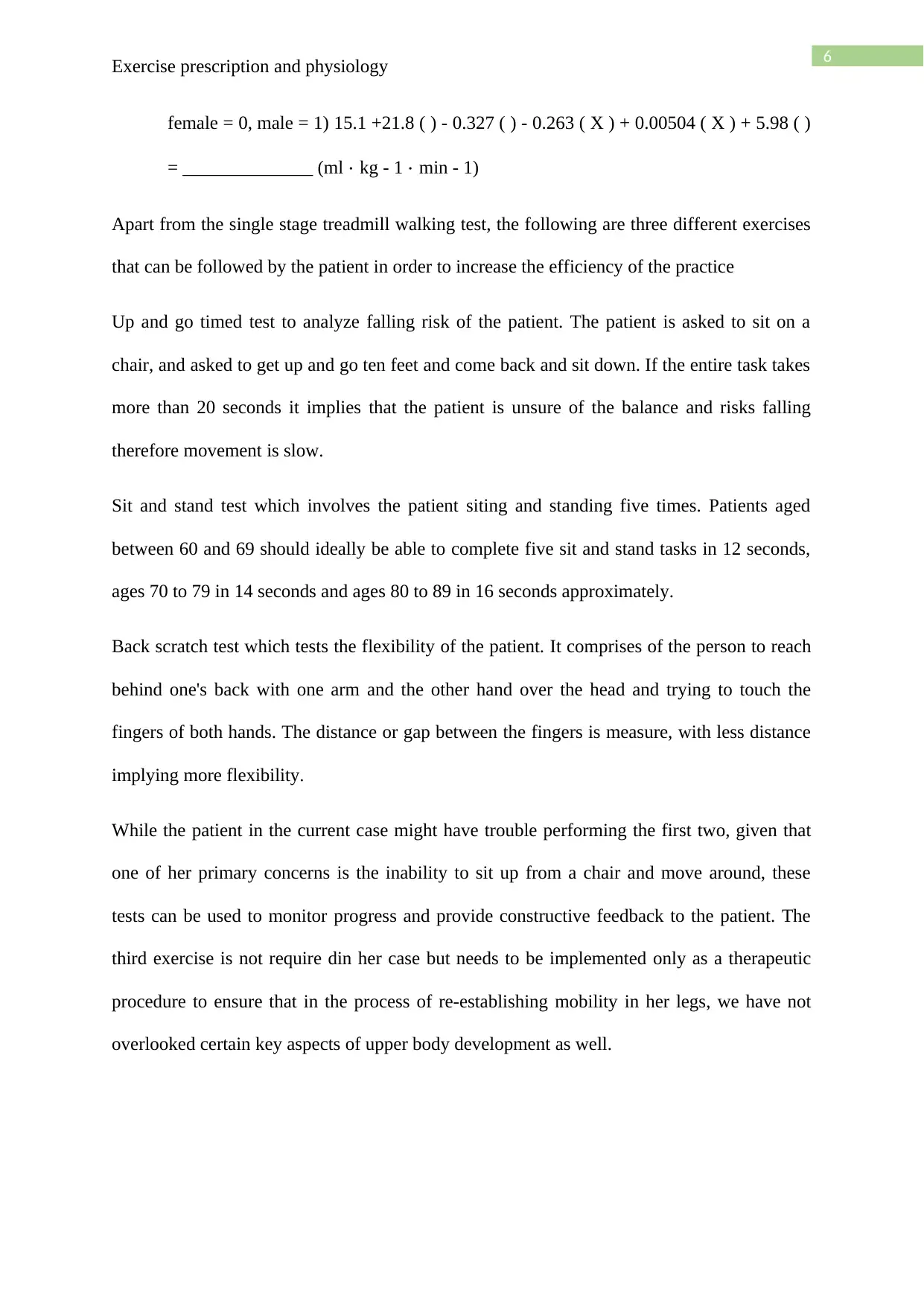
6
Exercise prescription and physiology
female = 0, male = 1) 15.1 +21.8 ( ) - 0.327 ( ) - 0.263 ( X ) + 0.00504 ( X ) + 5.98 ( )
= ______________ (ml ⋅ kg - 1 ⋅ min - 1)
Apart from the single stage treadmill walking test, the following are three different exercises
that can be followed by the patient in order to increase the efficiency of the practice
Up and go timed test to analyze falling risk of the patient. The patient is asked to sit on a
chair, and asked to get up and go ten feet and come back and sit down. If the entire task takes
more than 20 seconds it implies that the patient is unsure of the balance and risks falling
therefore movement is slow.
Sit and stand test which involves the patient siting and standing five times. Patients aged
between 60 and 69 should ideally be able to complete five sit and stand tasks in 12 seconds,
ages 70 to 79 in 14 seconds and ages 80 to 89 in 16 seconds approximately.
Back scratch test which tests the flexibility of the patient. It comprises of the person to reach
behind one's back with one arm and the other hand over the head and trying to touch the
fingers of both hands. The distance or gap between the fingers is measure, with less distance
implying more flexibility.
While the patient in the current case might have trouble performing the first two, given that
one of her primary concerns is the inability to sit up from a chair and move around, these
tests can be used to monitor progress and provide constructive feedback to the patient. The
third exercise is not require din her case but needs to be implemented only as a therapeutic
procedure to ensure that in the process of re-establishing mobility in her legs, we have not
overlooked certain key aspects of upper body development as well.
Exercise prescription and physiology
female = 0, male = 1) 15.1 +21.8 ( ) - 0.327 ( ) - 0.263 ( X ) + 0.00504 ( X ) + 5.98 ( )
= ______________ (ml ⋅ kg - 1 ⋅ min - 1)
Apart from the single stage treadmill walking test, the following are three different exercises
that can be followed by the patient in order to increase the efficiency of the practice
Up and go timed test to analyze falling risk of the patient. The patient is asked to sit on a
chair, and asked to get up and go ten feet and come back and sit down. If the entire task takes
more than 20 seconds it implies that the patient is unsure of the balance and risks falling
therefore movement is slow.
Sit and stand test which involves the patient siting and standing five times. Patients aged
between 60 and 69 should ideally be able to complete five sit and stand tasks in 12 seconds,
ages 70 to 79 in 14 seconds and ages 80 to 89 in 16 seconds approximately.
Back scratch test which tests the flexibility of the patient. It comprises of the person to reach
behind one's back with one arm and the other hand over the head and trying to touch the
fingers of both hands. The distance or gap between the fingers is measure, with less distance
implying more flexibility.
While the patient in the current case might have trouble performing the first two, given that
one of her primary concerns is the inability to sit up from a chair and move around, these
tests can be used to monitor progress and provide constructive feedback to the patient. The
third exercise is not require din her case but needs to be implemented only as a therapeutic
procedure to ensure that in the process of re-establishing mobility in her legs, we have not
overlooked certain key aspects of upper body development as well.
Paraphrase This Document
Need a fresh take? Get an instant paraphrase of this document with our AI Paraphraser
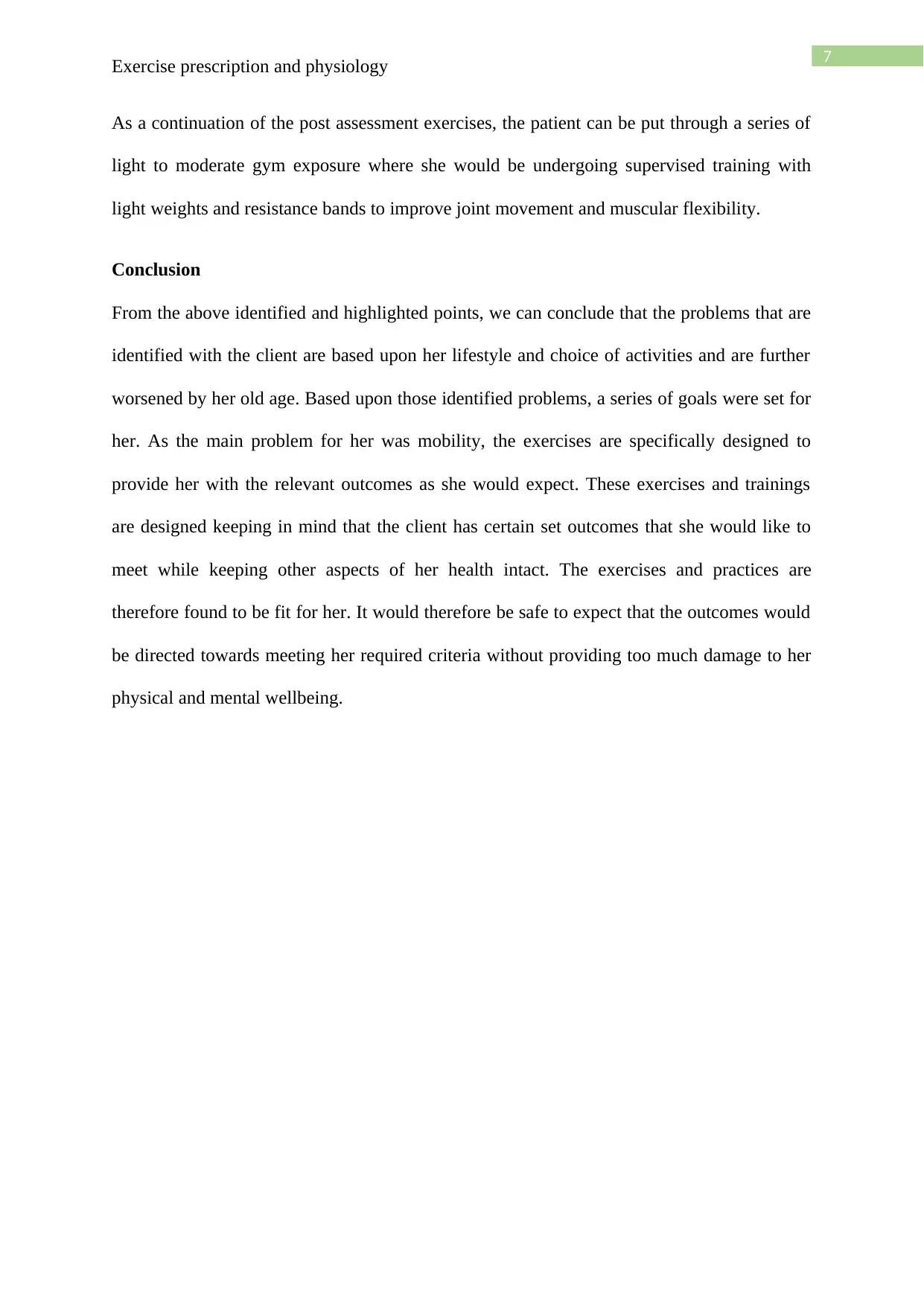
7
Exercise prescription and physiology
As a continuation of the post assessment exercises, the patient can be put through a series of
light to moderate gym exposure where she would be undergoing supervised training with
light weights and resistance bands to improve joint movement and muscular flexibility.
Conclusion
From the above identified and highlighted points, we can conclude that the problems that are
identified with the client are based upon her lifestyle and choice of activities and are further
worsened by her old age. Based upon those identified problems, a series of goals were set for
her. As the main problem for her was mobility, the exercises are specifically designed to
provide her with the relevant outcomes as she would expect. These exercises and trainings
are designed keeping in mind that the client has certain set outcomes that she would like to
meet while keeping other aspects of her health intact. The exercises and practices are
therefore found to be fit for her. It would therefore be safe to expect that the outcomes would
be directed towards meeting her required criteria without providing too much damage to her
physical and mental wellbeing.
Exercise prescription and physiology
As a continuation of the post assessment exercises, the patient can be put through a series of
light to moderate gym exposure where she would be undergoing supervised training with
light weights and resistance bands to improve joint movement and muscular flexibility.
Conclusion
From the above identified and highlighted points, we can conclude that the problems that are
identified with the client are based upon her lifestyle and choice of activities and are further
worsened by her old age. Based upon those identified problems, a series of goals were set for
her. As the main problem for her was mobility, the exercises are specifically designed to
provide her with the relevant outcomes as she would expect. These exercises and trainings
are designed keeping in mind that the client has certain set outcomes that she would like to
meet while keeping other aspects of her health intact. The exercises and practices are
therefore found to be fit for her. It would therefore be safe to expect that the outcomes would
be directed towards meeting her required criteria without providing too much damage to her
physical and mental wellbeing.
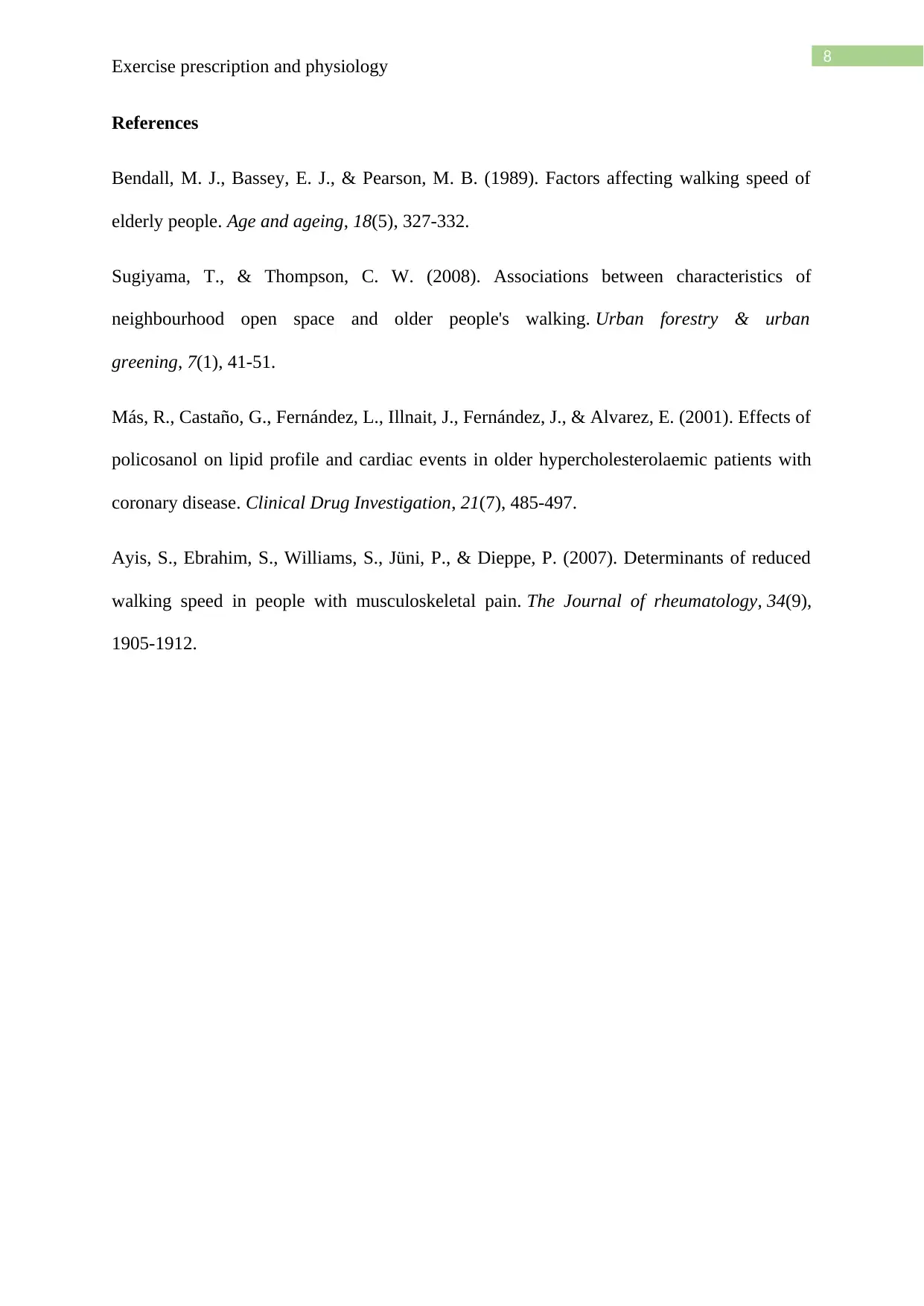
8
Exercise prescription and physiology
References
Bendall, M. J., Bassey, E. J., & Pearson, M. B. (1989). Factors affecting walking speed of
elderly people. Age and ageing, 18(5), 327-332.
Sugiyama, T., & Thompson, C. W. (2008). Associations between characteristics of
neighbourhood open space and older people's walking. Urban forestry & urban
greening, 7(1), 41-51.
Más, R., Castaño, G., Fernández, L., Illnait, J., Fernández, J., & Alvarez, E. (2001). Effects of
policosanol on lipid profile and cardiac events in older hypercholesterolaemic patients with
coronary disease. Clinical Drug Investigation, 21(7), 485-497.
Ayis, S., Ebrahim, S., Williams, S., Jüni, P., & Dieppe, P. (2007). Determinants of reduced
walking speed in people with musculoskeletal pain. The Journal of rheumatology, 34(9),
1905-1912.
Exercise prescription and physiology
References
Bendall, M. J., Bassey, E. J., & Pearson, M. B. (1989). Factors affecting walking speed of
elderly people. Age and ageing, 18(5), 327-332.
Sugiyama, T., & Thompson, C. W. (2008). Associations between characteristics of
neighbourhood open space and older people's walking. Urban forestry & urban
greening, 7(1), 41-51.
Más, R., Castaño, G., Fernández, L., Illnait, J., Fernández, J., & Alvarez, E. (2001). Effects of
policosanol on lipid profile and cardiac events in older hypercholesterolaemic patients with
coronary disease. Clinical Drug Investigation, 21(7), 485-497.
Ayis, S., Ebrahim, S., Williams, S., Jüni, P., & Dieppe, P. (2007). Determinants of reduced
walking speed in people with musculoskeletal pain. The Journal of rheumatology, 34(9),
1905-1912.
⊘ This is a preview!⊘
Do you want full access?
Subscribe today to unlock all pages.

Trusted by 1+ million students worldwide
1 out of 9
Your All-in-One AI-Powered Toolkit for Academic Success.
+13062052269
info@desklib.com
Available 24*7 on WhatsApp / Email
![[object Object]](/_next/static/media/star-bottom.7253800d.svg)
Unlock your academic potential
Copyright © 2020–2025 A2Z Services. All Rights Reserved. Developed and managed by ZUCOL.